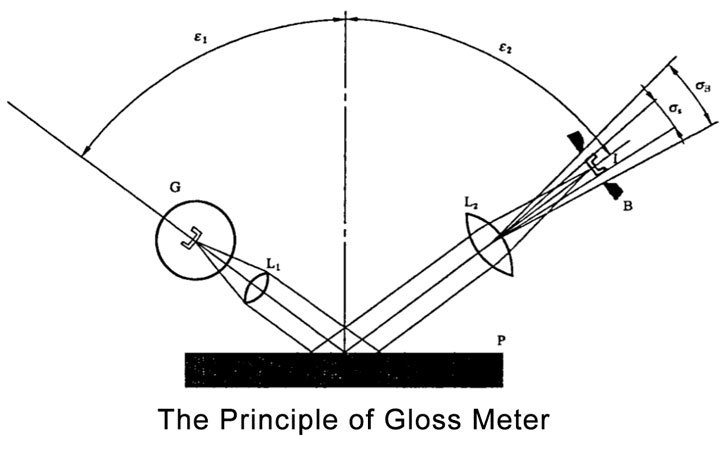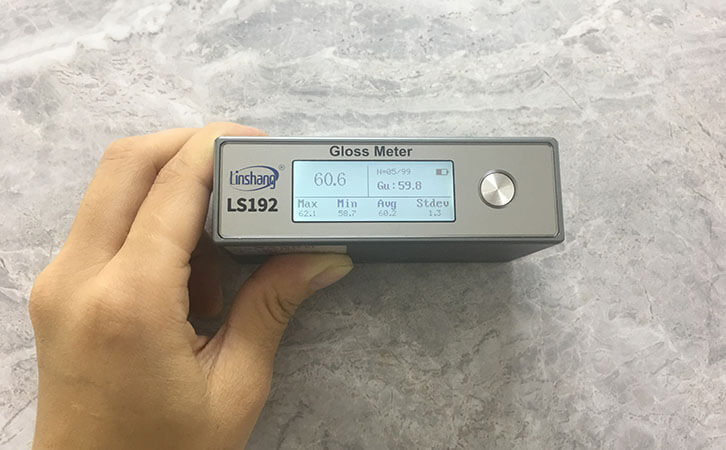FAQ of Specular Gloss Meter
The stone specular gloss meter is a professional tool that can measure the stone gloss by using the light reflection principle. Customers who need to test the stone gloss will encounter various problems before purchase and during the use of the specular gloss meter. So we will answer some common questions in this article.
1. What is the principle of detecting stone gloss?
The stone specular gloss meter consists of a light source, a lens, a receiver and a display screen. The measurement principle is shown in the figure below. The specular gloss meter usually has different test angles. This angle refers to the incident light and the line perpendicular to the plane. Common geometric angles of 20 degree, 60 degree and 85 degree. Under the specified light source and geometric angle, a beam of light is irradiated onto the measured object surface. Then the ratio of the luminous flux reflected back from the object surface to the light flux reflected by the standard board multiplied by 100 is the measured object gloss. (The standard board adopt the perfect polished black glass with a refractive index of 1.567 and a gloss of 100)

Principle of the stone specular gloss meter
2. How to choose the angle of the stone specular gloss meter?
"GB/T 13891-2008 Method for Measuring the Glossiness of Architectural Finishing Materials" stipulates that the mirror gloss test of various architectural facing materials can be measured with a 60 degree angle specular gloss meter. The test obtained gloss is greater than 70 when measured with a 60 degree stone specular gloss meter, you can choose a 20 degree angle stone specular gloss meter to improve the degree of resolution. If the gloss is less than 10GU, you can choose the 85 degree angle specular gloss meter. Of course, there are many 60 degree general-purpose stone specular gloss meters with very high resolution and precision. It is not necessary to replace other geometric angle instruments.
3. Is GU a gloss unit?
GU is not a gloss unit, it is the first letter of Gloss Unit, the English word for gloss. From the above introduction, we can know that the gloss of the test object is calculated by the ratio when the gloss of the standard board is 100.
4. What are the requirements for stone when testing gloss?
At the time of inspection, the surface of the stone should be smooth and free of appearance defects such as protrusions or warpage. Secondly, the size of the tested stone is also required. Take Linshang stone specular gloss meter LS192 as an example. The measuring spot size of the instrument is 9*15mm, so the size of the measured stone must be bigger than the measuring spot size of the instrument.
5. How to confirm the final gloss value?
When detecting the stone gloss, it is impossible to make the gloss data of each position consistent, so it is necessary to test a plurality of points and then average them. It is generally recommended to take a point in the center of the tested stone and each of the four corners or to test the center point and the eight points around the center point. After obtaining five or nine gloss data, the average value is obtained. If the highest and lowest values are too much above the average, it can also indicate that the uniformity is not good.
Data statistics function of the stone specular gloss meter
The Linshang LS192 stone specular gloss meter can automatically calculate the average and standard deviation, reducing the workload of manual statistics. The average value is the data we need to record. The smaller the standard deviation, the smaller the difference between the tested data and the average value. The gloss uniformity of the stone would be better.
The above is some of the frequently asked questions about the stone specular gloss meter. If you have more questions, you can also contact us via the contact information on the website. Or you can also read "How to Measure Gloss with A Gloss Meter?".
